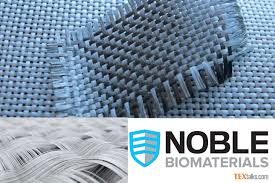“Shielding the Future: Noble Biomaterials’ Circuitex and Its Revolutionary Role in Countering Directed-Energy Threats”
Noble Biomaterials’ Circuitex: Advanced Textiles for Modern Threats
Greetings, textile enthusiasts! Today, we are diving deep into an intriguing and groundbreaking area of smart textiles: Noble Biomaterials’ Circuitex technology, potentially a game-changer in defending against the mysterious and dangerous “Havana Syndrome” energy attacks. Let’s unravel the tapestry of innovation behind Circuitex, and shed light on some fascinating aspects of technical textiles and energy mitigation systems that make this masterpiece so compelling.
A New Frontier in Defensive Textiles
Noble Biomaterials, renowned for their creation of advanced antimicrobial systems and conductive energy textiles, has recently made waves with their Circuitex technology. This isn’t just any textile; Circuitex is a fabric infused with the power to reflect high-frequency energy waves. According to Noble, this capability is crucial for mitigating risks posed by suspected directed-energy weapons (DEWs)—the type of threats potentially responsible for “Havana Syndrome” attacks targeting U.S. diplomatic and military personnel globally.
Understanding the Threat: Havana Syndrome and DEWs
Before diving into Circuitex, it’s essential to understand what it’s up against. “Havana Syndrome” refers to a series of unexplained health incidents that first emerged among U.S. embassy staff in Havana, Cuba, manifesting as auditory sensations, dizziness, cognitive disruptions, and even brain injuries. Initially, these occurrences seemed inexplicable until theories about DEWs—devices that emit focused energy waves to damage targets—came into play. These waves can penetrate and impact human tissue, causing acute and chronic health issues.
Noble’s Ingenious Solution: Circuitex Technology
So, how does Circuitex stand as a bulwark against these insidious attacks? The beauty of Circuitex lies in its multi-spectral energy management capabilities. This high-tech textile can scatter and shield energy waves, reducing their power by up to 100 decibels. For context, 100 decibels is akin to lowering the sound of a chainsaw to a faint whisper. This remarkable level of protection is far above industry standards, ensuring significant mitigation of harmful energy exposures.

Smart Textiles Explained: Keywords and Key Components
To appreciate the marvel that is Circuitex, let’s explore some key terms and components integral to smart and technical textiles:
1. Conductive Textiles**: These are fabrics capable of conducting electricity. They are often woven with conductive fibers such as silver, carbon, or steel, which makes them ideal for applications ranging from wearable electronics to electromagnetic interference (EMI) shielding, a critical feature of Circuitex.
2. EMI/RFI Shielding**: Electromagnetic Interference (EMI) and Radio-Frequency Interference (RFI) shielding involves blocking disruptive electromagnetic fields. This is crucial in protecting sensitive electronic equipment and in medical contexts. Circuitex’s prowess in EMI/RFI shielding ensures it can deflect unwanted energy intrusions effectively.
3. Directed-Energy Weapons (DEWs)**: As mentioned earlier, these weapons use focused energy—like microwaves or lasers—to inflict damage. Smart textiles like Circuitex aim to neutralize such threats by absorbing or deflecting the energy before it can cause harm.
4. Thermal and Electrical Conductivity**: A fabric’s ability to conduct heat and electricity is crucial for various applications, from keeping soldiers warm in cold climates to ensuring optimal functioning of integrated electronic components.
5. Biometric Monitoring**: This is an emerging application for conductive textiles, where smart fabrics can monitor health indicators such as heart rate and body temperature, proving invaluable in medical and fitness settings.
The Versatile Applications of Circuitex
Circuitex’s flexibility is another layer of its awe-inspiring potential. Available as fiber, fabric, and foam, Circuitex can be incorporated into both soft and hard surfaces, adaptable for fixed and mobile deployments. Think of it in terms of:
1. Apparel**: Imagine a new generation of clothing that not only shields the wearer from environmental threats but also integrates seamlessly into everyday attire, offering style and safety simultaneously.
2. Shelters and Tents**: For military and emergency response teams, Circuitex could be integrated into shelters and tents to provide a protective haven against DEWs, transforming simple canvas into robust defense systems.
3. Medical Devices**: Given Noble Biomaterials’ FDA registration as a medical device facility, Circuitex also holds promise in the medical field, potentially enhancing devices with protective capabilities against harmful energy forms.
4. Structural Applications**: Beyond textiles, Circuitex can coat walls or even be used in wallpapers, offering protective layers in critical infrastructures like governmental and diplomatic buildings.
Technology with Military Precision
Noble Biomaterials has rigorously developed Circuitex with the highest standards in mind—those of the U.S. military and Department of State. Such stringent validations ensure that this technology can perform under the most demanding conditions, offering consistency and top-notch protection across a broad electromagnetic spectrum. Joel Furey, founder and chief commercial officer at Noble Biomaterials, emphasizes the importance of this technology in mission-critical military and aerospace applications, showcasing the strategic value of Circuitex in modern defense.
Beyond the Battlefield: Commercial and Civilian Uses
While Circuitex’s military applications are evident, its potential extends into civilian realms. Everyday consumer products like tapes, wallpapers, and even certain types of apparel could soon feature Circuitex, offering enhanced protection to individuals in their daily environments. This is particularly relevant as concerns about cyber and energy attacks rise.
Consider the evolving smart home: future-proofing homes with integrated Circuitex materials could become a norm, where every wall, curtain, or piece of furniture not only serves its conventional purpose but also shields against potential energy-based threats.
Noble’s Commitment to Innovation and Safety
Noble Biomaterials’ endeavor with Circuitex underlines their broader mission: merging advanced textile technology with practical applications to enhance safety and functionality. As an Environmental Protection Agency (EPA)-registered antimicrobial manufacturer, Noble also emphasizes sustainability and public health, crucial considerations in today’s market.
The Future of Technical Textiles
The discussion around Circuitex propels us into the broader, exhilarating field of technical textiles. These are no longer just fabrics—they are intelligent, reactive, and often life-saving materials, heralding a future where textiles seamlessly integrate with technology to create responsive environments and garments. Here are a few trends to watch:
1. Wearable Health Monitors**: Smart textiles that provide real-time health monitoring, leading to proactive health management.
2. Adaptive Fabrics**: Textiles that can change properties based on environmental conditions, such as temperature-responsive clothing.
3. Energy Harvesting Fabrics**: Clothes that can generate power through body movement or thermal gradients, potentially charging personal electronics on the go.
4. Environmental Sensing Fabrics**: Materials integrated with sensors to detect pollutants or hazardous chemicals, ensuring safer environments.
Conclusion: Textiles at the Forefront of Modern Security
Noble Biomaterials’ Circuitex exemplifies how advanced textiles are venturing beyond their traditional roles, emerging as critical components in modern security and personal protection. The synergy of innovative materials like Circuitex with applications across military, medical, and commercial domains heralds a new era where what we wear and surround ourselves with directly contributes to our safety and well-being.
Stay tuned, fellow textile aficionados, as we continue to explore the limitless potentials of smart textiles. The fabric of the future is not just woven with threads but with cutting-edge technology that transforms and protects our lives, quilting together a safer, smarter world. Keep your looms ready for the next big weave in the world of textiles!
Until next thread,
Textile Topher
Keywords: Circuitex, Directed-Energy Weapons (DEWs), Electromagnetic Interference (EMI), (Post number: 66), Havana Syndrome, Protective textiles





